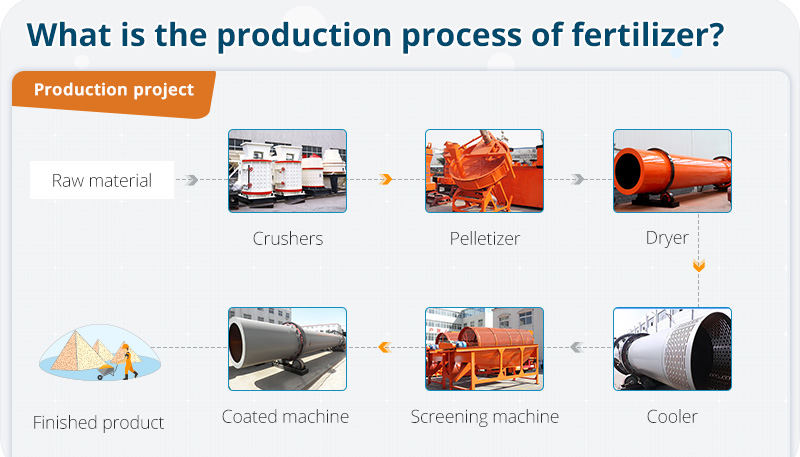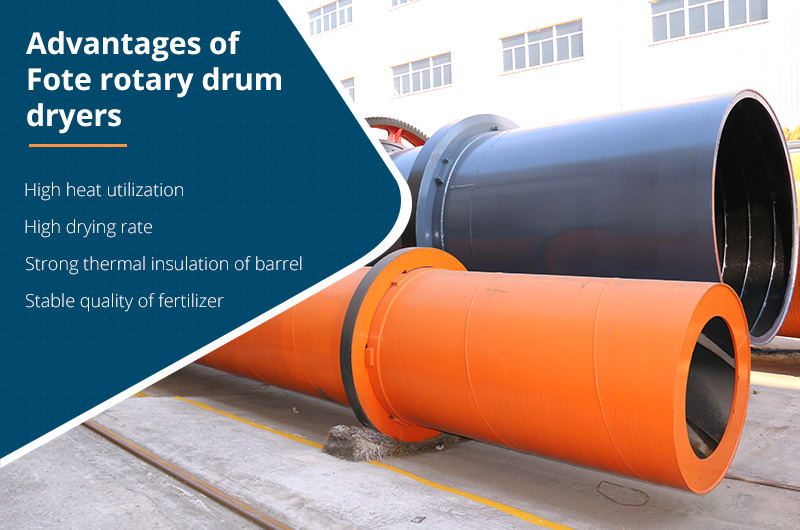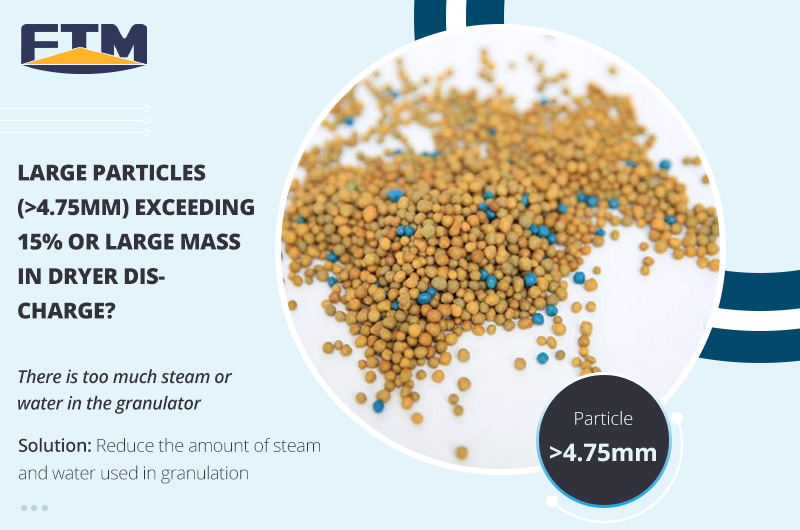Drying, an indispensable process in the fertilizer production process, directly affects yield, quality and energy consumption. The rotary drum dryer can dry fertilizers with a moisture content of 70%-80% to 13%, which is an ideal machine for drying chemical fertilizers.
Which fertilizers need to be dried?
In the fertilizer production process, all kinds of chemical fertilizers need to be dried, including nitrogen fertilizer, phosphate fertilizer, potash fertilizer, compound (NPK) fertilizer, compost fertilizer, organic fertilizer, etc.
The following table will briefly introduce the composition and characteristics of these fertilizers:
| Types | Names | Composition (content) | Characteristics |
| Nitrogen fertilizer | Urea | N (46%) | Certain hygroscopicity, slow fertilizer effect |
| Ammonium sulfate | N (21%) | Weak hygroscopicity, soluble in water | |
| Ammonium chloride | N (25%) | ||
| Ammonium nitrate | N (35%) | Strong hygroscopicity, water solubility | |
| Phosphate fertilizer | Superphosphate | P205 (12-18%) | Caking, water solubility |
| Phosphorite powder | P205 (10-25%) | A bit slow fertilizer effect | |
| Potash fertilizer | Potassium chloride | K20 (50-60%) | Caking, soluble in water |
| Potassium sulfate | K20 (50-58%) | Hard to caking, soluble in water | |
| Compound (NPK) fertilizer | Ferrous sulfate | N (8%), P205 (45%) | Weak hygroscopicity, hard to caking |
| KDP | P205 (51%), K20 (34%) | ||
| Organic fertilizer | Livestock manure | Organic material(≥45%) | Slow fertilizer effect |
| Weeds, stems, straws, waste, etc. |
What is the production process of fertilizer?

The production process of chemical fertilizer
- 1 Fertilizer crushing and granulation: The raw materials are stirred and crushed, then fed into the disc granulator for granulation.
- 2 Granule drying: Feed the granules into the rotary drum dryer.
- 3 Granule cooling: The temperature of dried fertilizer granules is too high and easy to caking. After cooling, it is convenient for bag storage and transportation.
- 4 Particle grading: The cooled particles are graded so that unqualified particles can be crushed and re-granulated, while the qualified products can be screened out.
- 5 Coating and packaging of finished products: The qualified products are coated and stored in bags.
Why dry fertilizers?
The granulated fertilizer granules have high moisture content and are relatively humid. Moreover, the particles are easily crushed by hand with low strength, which does not meet the requirements of packaging and transportation.
Therefore, the fertilizer needs to be dried after granulation for water content reduction and second granulation.

Why dry fertilizer?
Water content reduction
The quality index of fertilizer requires that its water content should be lower than 14%, but the water content of the granules after granulation generally exceeds the index, so a rotary drum dryer is required for drying.
The dryer can dry the fertilizer with a moisture content of 70% ~ 80% to 13%, which meets the requirements of fertilizer quality indicators.
Second granulation
The dryer not only has the function of drying, but also secondary granulation. Dryers can improve the original moisture solubility of organic fertilizer by increasing the temperature.
With this liquid phase, organic fertilizers are easy to be pelleted with good viscosity, so the pellet formation rate is high with uniform particle size, low water content, which improves production yield.
Advantages of Fote rotary drum dryers
High heat utilization
As the rotary drum dryer is a heat conduction machine and the heat transfer direction is basically consistent throughout the heat transfer cycle, therefore, most of the heat supplied in the rotary drum is used for the moisture vaporization of materials and the thermal efficiency is up to 80% ~ 90%.
High drying rate
The heat and mass transfer of the wet film on the cylinder wall is from the inside to the outside with consistent direction and large temperature gradient, so the surface of organic fertilizer maintains a high evaporation intensity, generally up to 30~70 kg/(m2.h).

Advantages of Fote rotary drum dryers
Strong thermal insulation of barrel
Cylinder insulation materials include composite silicate insulation coating, silicate fiberboard, mineral wool board and so on. We also use wire mesh to reinforce the insulation layer.
After the heat preservation of the cylinder body is implemented, due to the reduction of body heat dissipation, the temperature of the inner wall rises, and the temperature drop of the hot air slows down, thereby accelerating the heat transfer speed and improving the heat transfer efficiency.
Stable quality of fertilizer
Because the heating mode is easy to control, the temperature inside the cylinder and the heat transfer rate of the partition can be kept relatively stable. As the material is dried under the heat transfer state, the quality of fertilizer can be guaranteed.
4 problems should be paid attention to in the process of drying fertilizer
1. The residence time of fertilizer in the rotary dryer
The residence time of organic fertilizer in a rotary dryer is generally > 22 min. Under the same conditions, the longer the dryer barrel is, the longer the material stays and the higher the thermal energy utilization rate is. Therefore, lengthening the dryer cylinder is very beneficial to make full use of heat energy.
2. Air volume of the dryer
The air volume directly affects the drying effect. It is generally calculated by the cross-sectional area of dryer barrel, and 7000 m/h is appropriate. Wind speed should be less than 2m/s.
A control valve should be installed on the pipeline before or after the fan to adjust the air volume.
For example, the blower should be equipped with a valve at the air inlet, which can increase the air volume of the blower to increase the temperature in the furnace when the furnace temperature is insufficient; as well as reduce the air volume to lower the temperature in the furnace if the temperature is too high.

Problems should be paid attention to in the process of drying fertilizer
3. Temperature of the rotary dryer
In order to avoid the death of effective live bacteria due to high temperature during the drying process, the drying temperature of compound fertilizers should not be higher than 60℃. The temperature of the hot air in contact with the material generally does not exceed 130°C.
The temperature at the inlet and outlet of the rotary dryer should be relatively stable:
| Types | Temperature difference between head and tail | Inlet gas temperature fluctuation range | Outlet gas temperature fluctuation range | Exhaust gas temperature |
| Temperature | About 100℃ | Within 10℃ | Within 2℃ | Within 75℃ |
For example, the decomposition temperature of urea is 132°C, and its softening temperature is 80°C.
When producing compound fertilizer with urea as the nitrogen source, it is safer to control the head temperature of the rotary dryer below 160°C and the tail part to 70°C to prevent the decomposition and softening grain deformation of urea.
4. Degree of heat exchange within the rotary dryer
Organic fertilizers are easy to melt and stick to the wall in high temperature, it increases the load of the equipment, so the lifting function of the plate in the rotary dryer cannot be fully exerted and the effect of heat exchange is reduced. The material will be hard to be dried and rounded. Equipment cleaning difficulties will also occur.
At this time, the layout density of the copy board, the dead angle and the impact of the external vibration hammer can be reduced.
Why abnormal conditions occur in fertilizer production and how to solve them?
1. Large particles (>4.75 mm) in the discharge of the dryer exceed 15% or large clusters appear.

Large particles in the discharge of the dryer exceed 15% or large clusters appear
① Too much steam or moisture in the granulator.
Solution: Reduce the amount of steam and water during granulation.
② The temperature inside the dryer exceeds the standard, so the solubility of compost fertilizer improves.
Solution: Lower the temperature at the inlet and outlet of the dryer.
③ The crusher does not crush large particles of compost fertilizer.
Solution: Restore the function of the crusher.
④ The proportion of viscous materials is too high.
Solution: Reduce the proportion of viscous materials.
2. The powder (<1 mm) in the particles at the outlet of the dryer exceeds 15%.

The powder in the particles at the outlet of the dryer exceeds 15%
① The liquid phase is insufficient during granulation.
Solution: Increase the amount of steam and moisture in the granulator appropriately.
② The compost fertilizer is not sufficiently viscous and cannot be granulated normally.
Solution: Adjust the formula and increase the amount of viscosity conditioner.
③ The material is not fine enough.
Solution: Crush the raw materials to more than 60 mesh (0.25 mm) to improve the viscosity of materials.
3. Compound fertilizer particles are pulverized in the rotary dryer.
The reason is that the pH value of monoammonium phosphate is particularly low, so its reaction with ammonium bicarbonate is particularly strong, resulting in more bubbles (CO2 emission). Over time, the particles in therotary dryer become loose and then turn to powder.
Solution: Add other alkaline materials, such as calcium magnesium phosphate fertilizer or bitter soil, instead of ammonium bicarbonate, so that it only undergoes acid-base neutralization reaction without any bubbles generated.
4. Polarization occurred in the final granules of the dryer, with powder and particle content greater than 15% and low qualification rate.
① Returned materials and fresh materials mix unevenly.
Solution: Mix the returned material and the new material thoroughly and uniformly throughout the process.
② The performance of the crusher decreases.
Solution: Improve the crushing function of the crusher and the viscosity of materials.
③ The temperature of the material during granulation is greater than 70℃.
Solution: Try to cool down the temperature of the material in the granulation area to 60~65℃. There are several ways: a. Add an appropriate amount of water to the mixer, about 2%; b. Add less steam and more water in the granulator; c. Lower the drying temperature to lower the return temperature.

